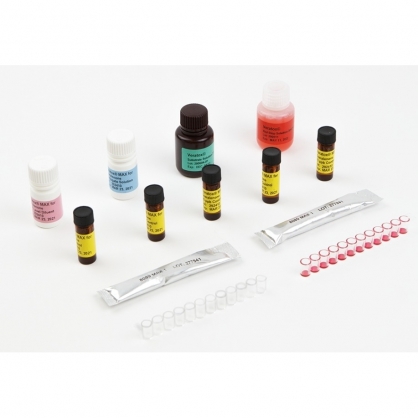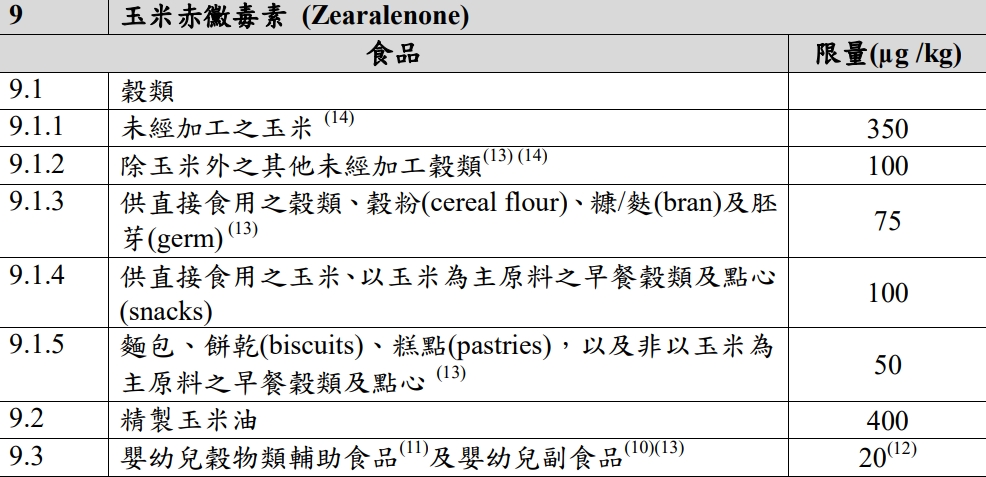- 原理
酵素連結免疫分析法Enzyme-linked immunosorbent assay (ELISA),利用抗原和抗體之間專一性鍵結的特性,並加入顯色酵素和酵素受質,利用顯色的深淺,對檢體進行檢測的分析方法。ELISA可使用標準曲線法 (standard curve) 進行定量,透過檢體的吸光值與標準品進行比對,即可得到檢體的對應濃度。競爭法(competitive ELISA) 一般用於分子量較小的抗原檢測,在抗體數量固定的塑膠孔盤上,加入可鍵結的酵素抗原及檢體抗原,兩種抗原皆會競爭塑膠孔盤上抗體鍵結,當檢體中抗原含量越多,顯色也就越淺
玉米赤黴烯酮(Zearalenone)又稱玉米烯酮或F-2 toxin,此毒素主要由真菌-鐮孢菌(Fusarium spp.)產生,玉米赤黴烯酮由於在結構上類似雌激素,因此能與雌激素受體結合,引發類似雌激素之效應,故此毒素主要針對動物之生殖系統產生毒性
- 結果判讀
極限:
偵測極限(limit of detection, LOD): 19.5 ppb
定量極限(limit of quantification, LOQ):25 ppb
偵測範圍:25-500 ppb(樣品超過500ppb需重新稀釋及測量)
- 樣品準備和萃取(SAMPLE PREPARATION AND EXTRACTION)
The sample to be tested should be collected according to accepted sampling techniques (see FGIS sampling protocol or contact your Neogen representative). Obtain a representative sample (minimum 100 g). Grind the entire sample so that at least 95% of the ground material passes through a 20-mesh sieve (about the particle size of fine espresso).
1. Weigh out 10 g ± 0.1 g of sample into a container cup. Pour contents of 1 MAX 2 Aqueous Extraction Packet into the container cup.
2. Add 50 mL distilled or deionized water over the sample and extraction powder.
3. Cap tightly, then shake to moisten the entire sample. Vigorously shake, using hand or mechanical means, for three minutes. Let sample settle.
4. Filter the extract by pouring through a Whatman #4 filter, or use a filter syringe and collect a minimum of 3 mL filtrate in a sample collection tube.
5. You may also pipette 1 mL of sample into a 1.5 mL microcentrifuge tube and centrifuge for 30 seconds using the microcentrifuge.
6. Dilute the sample extract 1:10 by mixing 100 µL sample extract with 900 µL distilled or deionized water in a clean sample collection tube. Mix well.
7. The sample is now ready for testing.
- 定量-操作流程(TEST PROCEDURE)
Allow reagents to warm to room temperature 18-30oC (64-86oF) prior to use.
1. Remove 1 red-marked mixing well for each sample to be tested plus 5 red-marked wells for controls, and place in the well holder.
2. Remove an equal number of antibody-coated wells. Return antibody wells, which will not be used immediately, to the foil pack with desiccant and reseal the pack to protect the antibody. Mark one end of strip with a “1” and place strip in the well holder with the marked end on the left.
3. Mix each reagent by swirling the reagent bottle prior to use.
4. Place 100 µL of conjugate from the blue-labeled bottle in each red-marked mixing well.
5. Using a new pipette tip for each, transfer 100 µL of controls and diluted samples to the red-marked mixing wells as shown below.
6. Using a 12-channel pipettor, mix the liquid in the wells by pipetting it up and down 5 times. Transfer 100 µL to the antibody-coated wells. Mix by sliding the microwell holder back and forth on a flat surface for 30 seconds without splashing the reagents from the wells. Incubate for 10 minutes at room temperature 18–30°C (64–86°F). Discard the red-marked mixing wells.0 25 75 150 500 S1 S2 S3 S4 S5 S6 S7 strip 1 S8 S9 S10 S11 S12 S13 S14 S15 S16 S17 S18 S19 strip 2
7. Shake out the contents of the antibody wells.
8. Fill each antibody well with distilled or deionized water and dump them out. Repeat this step 5 times, then turn the wells upside down and tap out on a paper towel until the remaining water has been removed.
9. Pour the needed volume of substrate from the green-labeled bottle into the green-labeled reagent boat and, with new tips, pipette 100 µL of substrate into the wells and mix by sliding back and forth on a flat surface for 30 seconds. Incubate 5 minutes. Discard remaining substrate and rinse the reagent boat with water.
10. Pour Red Stop solution from the red-labeled bottle into the red-labeled reagent boat. Add new tips to the 12-channel pipettor, prime the tips and pipette 100 uL of red stop into the wells. Mix by sliding back and forth on a flat surface for 30 seconds. Discard the tips.
11. Wipe the bottom of the microwells with a dry cloth or towel and read in a microwell reader using a 650 nm filter. Air bubbles should be eliminated, as they could affect analytical results. Results must be read within 20 minutes after the addition of Red Stop.
12. Read and calculate results using Neogen’s Stat Fax microwell reader or equivalent. If using another strip/plate reader, calculate results using Neogen’s Veratox for Windows software.
- 掃描-操作流程(TEST PROCEDURE – FOR SCREENING)
Allow reagents to warm to room temperature, 18-30oC (64-86oF), prior to use.
1. Remove 1 red-marked mixing well for each sample to be tested plus 1 red-marked well for the control, and place in the well holder.
2. Remove an equal number of antibody-coated wells. Return antibody wells, which will not be used immediately, to the foil pack with desiccant and reseal the pack to protect the antibody. Mark one end of strip with a “1” and place strip in the well holder with the marked end on the left.
3. Mix each reagent by swirling the reagent bottle prior to use.
4. Place 100 µL of conjugate from the blue-labeled bottle in each red-marked mixing well.
5. Choose one control level to screen samples against for each test performed. Using a new pipette tip for each, transfer 100 µL of the diluted samples and chosen control to the red-marked mixing wells as shown below. Thoroughly mix the sample and control with the conjugate as you add them to the well by depressing the plunger 5 times. Do not use more than 6 wells at one time.
6. Using a new tip for each, transfer 100 µL from each mixing well to the corresponding antibody-coated well. Mix by sliding the microwell holder back and forth on a flat surface for 30 seconds without splashing the reagents from the wells. Incubate for 10 minutes at room temperature, 18–30°C (64–86°F).control S1 S2 S3 S4 S5
7. Shake out the contents of the antibody wells.
8. Fill each antibody well with distilled or deionized water and dump them out. Repeat this step 5 times, then turn the wells upside-down and tap out on a paper towel until the remaining water has been removed.
9. Pipette 100 µL of substrate into each well and mix by sliding back and forth on a flat surface for 30 seconds. Incubate 5 minutes.
10. Pipette 100 µL Red Stop to each well and mix by sliding back and forth on a flat surface. Discard the tip.
11. Wipe the bottom of the microwells with a dry cloth or towel. Microwells may be read visually or using a 650 nm filter. If the sample well is blue or more blue than the control well, the sample contains less toxin than the control. If the sample well shows less blue color (more red color) than the control, the sample contains more toxin than the control. For optimum observation of color differences, place the wells on a white surface and read looking down through the solution.
- 稀釋步驟(DILUTION PROCEDURE)(樣品超過500ppb需重新稀釋及測量)
1. Dilute the original filtered sample extract 1:4 with High Level diluent from the pinklabeled bottle in a sample collection tube. For example, add 100 µL sample extract to a sample collection tube, then add 300 µL High Level Diluent from the pink-labeled bottle and mix well.
2. Dilute this extract 1:10 in distilled or deionized water by mixing 100 µL sample extract with 900 µL distilled or deionized water in a clean sample collection tube. Mix well.
3. The diluted sample is now ready for testing.
商品特色
商品規格
- 商品規格(48個檢測反應)
1️⃣48 antibody-coated wells
2️⃣48 red-marked mixing wells
3️⃣05 yellow-labeled bottles of 0, 25, 75, 150, and 500 ppb zearalenone controls
4️⃣01 blue-labeled bottle of zearalenone HRP conjugate solution
5️⃣01 green-labeled bottle of K-Blue® Substrate solution
6️⃣01 red-labeled bottle of Red Stop Solution
7️⃣01 pink-labeled bottle of high level diluent
8️⃣25 MAX 2 aqueous extraction packets



